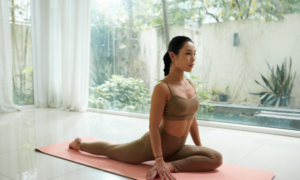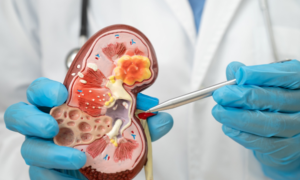Step 1: Relieve Muscle Tension
Self-Massage
The simplest way to relieve muscle tension is to gently massage the sore area with your hands.

Thoracic Spine Release With a Massage Ball
- Lie on your back.
- Place a massage ball at the thoracic spine just below your neck and work it along the edges of the shoulder blades to locate areas of tension.
- To reach deeper spots, raise the arm on the side you are massaging and stretch it across to the opposite side. This movement helps open up the shoulder blade, creating more space for the massage.
When using a massage ball to target sore spots in the neck, avoid pressing directly on the cervical spine, as it is delicate and packed with nerves.
Step 2: Improve Thoracic Mobility

Quadruped Scapular Push-Ups
Steps:
- In a tabletop position, place your hands directly under your shoulders and align your knees beneath your hips.
- Squeeze your shoulder blades together, and let your upper back sink slightly. Hold for 10 seconds.
- Spread your shoulder blades apart, arch your upper back as the blades move away from each other, and hold for 10 seconds.
- Repeat the movement several times.

Child’s Pose With Shoulder Stretch
Steps:
- Begin in a tabletop position with your knees hip-width apart and elbows placed slightly in front of your shoulders on the ground.
- Slowly push your hips back, gradually opening your chest and lowering it toward the floor to stretch your lower back. Hold the stretch for 10 seconds.
- Return your hips to the starting position and repeat the movement several times.
Step 3: Strengthen Neck Muscles

Supine Chin Tuck
Steps:
- Lie on your back on the floor.
- Gently press the base of your skull against the floor and slightly tuck your chin.
- Hold this position without moving for several seconds
This exercise helps strengthen the neck flexors and improve neck posture.

Banded Supine Chin Tuck
Steps:
- Start in the Supine Chin Tuck position.
- Place a resistance band under your feet and hold one end in each hand.
- Pull the band upward while keeping your chin tucked. You should feel a gentle stretch along the back of your neck.
- Hold the position briefly before slowly releasing.
This exercise further strengthens the neck flexors by adding resistance.














